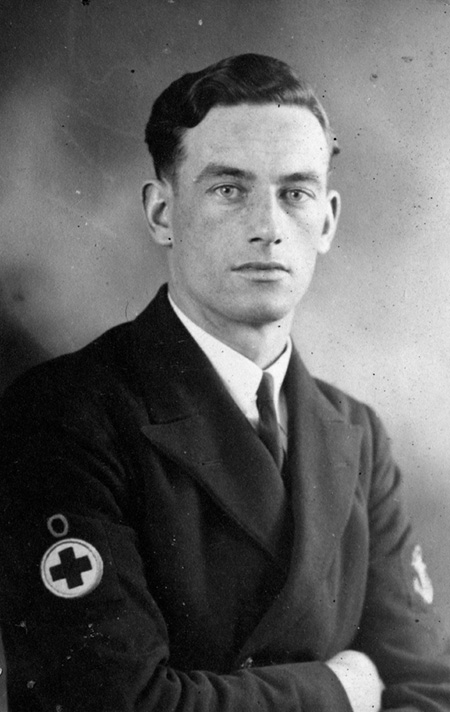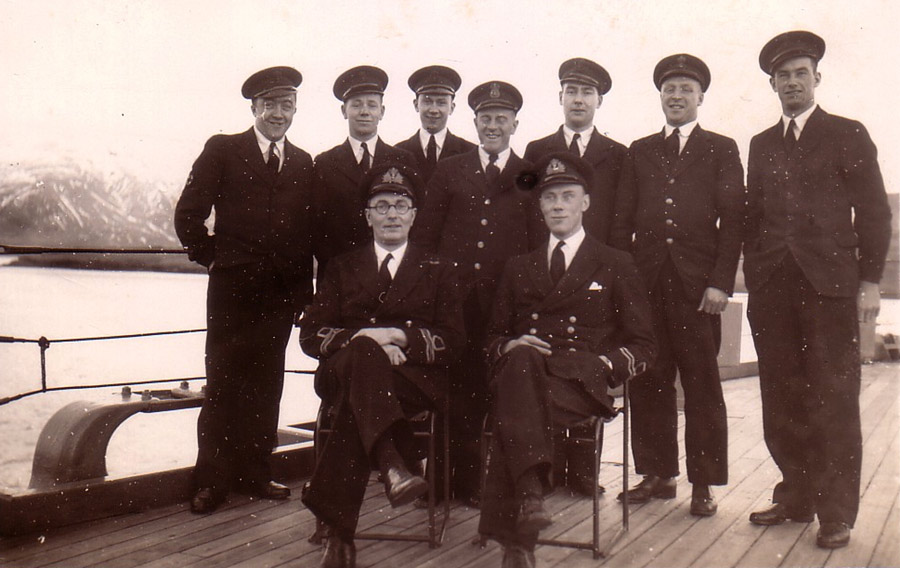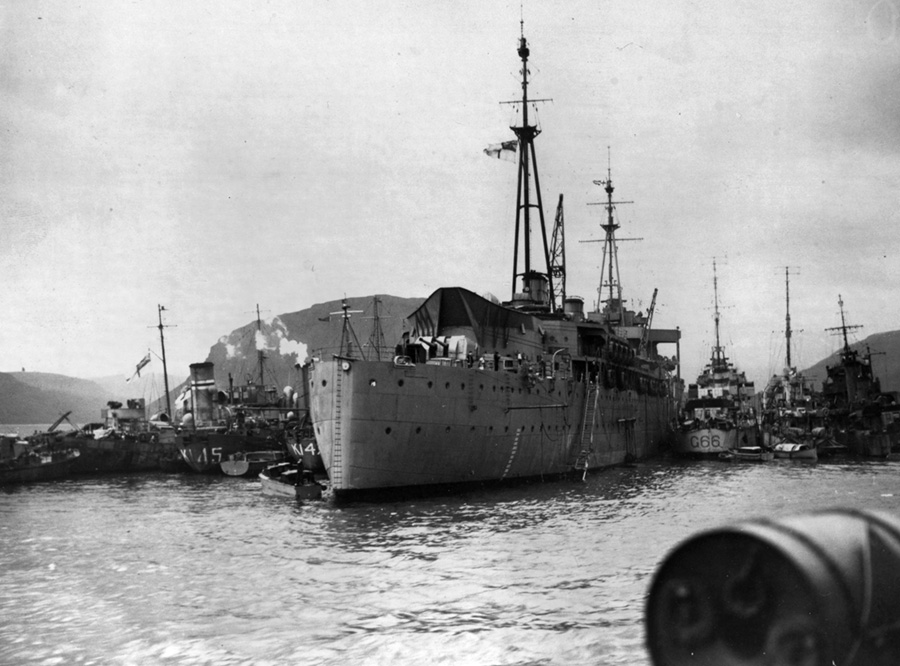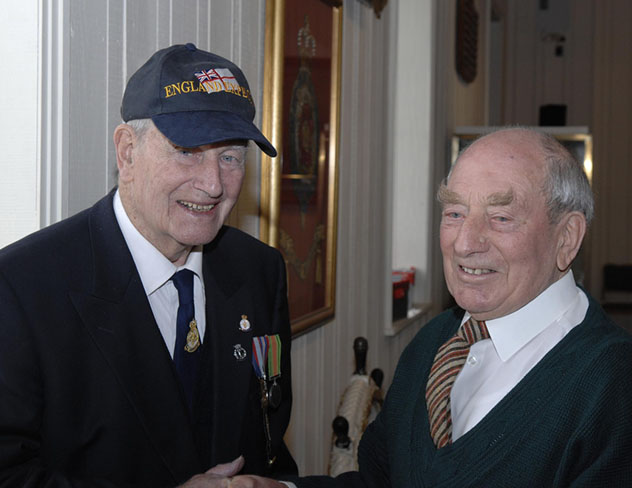







George
Male described how he came to join the Sick Bay Branch of the Royal
Navy in a letter to Greg Clark, the "Schoolie" (schoolmaster) on HMS Hecla, the author of Doc: One Hundred Year History of the Sick Berth Branch (Royal Navy Museum, 1984):
"I was born in Plymouth, 26.8.1919. My father went to sea at 13, later served in the Royal Navy and HM Dockyard.
In 1939 he could not rest until he got a job in Devonport Barraks
although well past retiring age. I left school in 1936 and worked as a
junior clerk in the Health Dept. and at the City Hospital. In 1938
after the Munich Crisis I was given the job of ordering and arranging
storage of surgical and medical supplies for emergency hospitals if war
came. This meant that I added some knowledge of surgical instruments
etc to the rag bag of information I had acquired about diseases and
treatments as a result of reading patients notes while registering and
filing their records.
As
Ralph Wilton used to say 'The day war broke out ...' I got on my bike
and dashed off to the hospital ready to deal with the casualties I was
sure would be arriving any minute. As the work of the hospital
proceeded as normal I ent off to the Recruiting Office to volunteer for
the Army. hey were busy dealing with territorials etc and told me to
bugger off!
The
next day being Monday I went to the office as usual and the Medical
Superintendent informed me that I
should do no more about volunteering as I would be required to arrange
the dispersal of the emergency equipment. However, a few weeks later I
was informed that the Navy required specialist ratings for the Sick
Berth Staff - Physio, Radiographers, Pharmacists and Operating Staff.
The Med Supt. gave me a letterr saying that I would be useful in
operating, I applied and having passed the medical was given four
shillings pay for one day and told to report to the RNB Barracks,
Devonport. After going home to Mum for lunch I duly presented myself
with a large envelope at the main gate. Nobody seemed to want to know
me but I got a gas mask, tin hat and identity disc, then met a chief
who asked me where I lived - 'Down the road - 'Then push off and come
back tomorrow'. After three weeks following this routine daily I was
called
over the Tannoy to report for transport to RNH Stonehouse, still
without uniform or other kit. At the Theatre block I was given a cap,
mask and gown and sent into No. 1 theatre. In two weeks I learnt a lot
particularly from Frank Best a civilian ex member of the staff who
showed me how to set up and sterilise instruments, anaesthetic
trolleys, etc. Then I was sent on eight days Christmas leave - having
by now got a uniform and some items of kit.
On
my return to my horror I was told I was on draft (sorry Sir!), with
visions of being in charge of a theatre at sea, my leg was pulled
by the rest of the staff - a wooden battleship etc - it turned out to
be the wooden huts of HMS Raleigh then under construction at Torpoint."
George Male continues his story on the BBC Peoples War web site:
"That
was the beginning of January 1940. It was a shore base at Torpoint,
still being built. It was three months before any trainees came.
Adjoining the base was HMS Fishguard
training base for Artificers. One Sunday afternoon an apprentice came
to me, he was holding his hands together, opened them to show me his
left thumb in his right hand “Could you put this back Doc?” (We were
called ‘Doc’, the medical officer was the Quack!’) Peter Bull was an
actor he was at HMS Raleigh
and got tonsillitis, we took his tonsils out and he couldn’t each much
because of his sore throat, so a rich aunt sent him parcels from
Fortnum and Masons beautiful Dundee Cakes and we helped him out by
eating them. He was kept in sick bay longer then anyone else!
During
the blitz we had to take any patients out of the wooden huts to the
decontamination building. We then had to put up the fire hydrants to
get the fire extinguishers ready. There were four points to do them. I
ran the operating theatre and had "rabbits" hidden in the cupboard.
Rabbits were anything you couldn’t take ashore. My precious rabbits
were tobacco, a new shirt and handkerchiefs and they were very special
to me. I decided we’d put the first hydrant outside the theatre to
protect my rabbits. Two sick berth attendants and I lifted an 18 inch
man-hole cover, in the blitz in the dark on our hands and knees fishing
to fit a hydrant. A plane went over dropping a stick of bombs. We all
dived our heads down the man hole and our helmets jammed. When we got
out it was to find the sick quarters were badly damaged. We managed to
get through to the surgical wards. The bomb had dropped at the other
Hydrant which we should have placed first, it saved our lives deciding
to protect my rabbits. I’m too old to go to jail now.
In April 1941, I was suddenly sent on draft to report to HMS Drake
Devonport. After several days I was given a rail warrant and two meal
vouchers, two shillings each and was told to report to St Enochs Hotel,
Glasgow on my own. In the big office I shouted “Anybody know where HMS Hecla
is?” “No chief” came the answer so I was sent to Greenock and put
aboard the Royal Ulsterman a small ferry which used to run between
Scotland and Northern Ireland. Three days later we arrived unescorted
at Havalfjord Iceland which was a wartime Naval Base. Amongst the ships
there was HMS Hecla. Instead
of sending me to it the ship refuelled and took me to Reykjavik where I
was put ashore and spent my only night in a hammock in a stinking fish
factory taken over for accommodation, "dignified by the name HMS Baldur". Awful.
Next day I was put aboard
a little boat and was sent 40 miles around to pick up the Hecla. There
were two doctors and the senior one laughed when he saw me. He said ”I
have been sending signals to Admiralty for five months to send us a
surgical specialist and they’ve sent you! Well you won’t be here more
than three weeks”. No specialist came and I was still aboard when she
sank two years later.


The destroyer depot ship, HMS Hecla, moored in Havelfjord with destroyer escorts berthed alongside
Courtesy of George Male

"Uncle Cyril", Capt C.G.B. Coltart RN, being piped aboard HMS Hecla by his fellow officers dressed as ratings after a day's shootin' at Havelfjord in 1941
Lt Surgeon Stephen L Hetherington RNVR is facing centre
Courtesy of Dr Peter Hetherington
In
March 1942 we returned to the Clyde, did a refit and on the 15th of
April sailed in a huge convoy out into the Atlantic. Exactly a month
later we were off the Cape of Good Hope. I was on the upper deck after
tea when there was a bang and a lot of water came up. We’d hit a mine. We had 24 killed and nearly 200 injured
and operated on into the night with bodies on the floor around us. One
sailor had part of his brain protruding and was laid on the floor as it
appeared our efforts would be better spent on those with more chance to
survive. After a while he raised himself with one arm and asked for a
drink. We got him on the table, did what we could for him. He was still
alive next day, transferred to Royal Navy Hospital (RNH) Simonstown and survived. None died other than those killed by the explosion. We managed to get
into Simonstown having lost 72 torpedoes and 200 depth charges out of
the holes.
We had six months there while they put a new bottom on the
ship. We then sailed back up the Atlantic and at 11 at night I was in
my cot in the sick bay when there was an explosion. Two stokers managed
to get up from the boiler room before it was screwed down. They were
badly burned and we spent an hour attending to them. We gave them a
shot of morphine and sent them to the upper deck to await instruction.
We had been hit by two torpedos and then an hour later two more. I
never heard “Abandon Ship” but I found myself in the wardroom with a
junior doctor and a midshipman. We went through the mess decks to see
if there was anyone who couldn’t get off and then came back to the
wardroom. The ship was keeling to port. It was black and the junior
doctor (Lt Surgeon Stephen L. Hetherington RNVR) said “Male, I’ve sat here many a night at dinner dying for a pee
and unable to have one until the captain gave permission. Well I’m
having one now!” and the three of us made sure we didn’t pollute the
ocean, said good-bye and went over the side.
 I
went up the starboard rail, I could almost walk down the side it was
keeling over so far. The rope ended and I let go and found myself back
in the ship. I’d gone into a hole made by the torpedo. I was a good
swimmer and there was a destroyer HMS Marne
standing by to pick up survivors. I was swimming towards her and
amongst others in the water I saw the Master at Arms (Johnny Harbor) he
was standing upright in the water with his hands on the reading desk of
the ships lectern with his feet on the cross bar at the bottom. What
are you doing I said? He said “If I’m going to heaven boy I’m going in
style”. I got near the Marne. There was a swish in the water beside me. It was a torpeo which blew the stern off the Marne.
It was like being hit in the stomach by a board, really unpleasant. She
had a pattern of depth charges set. They were thrown of and exploded
around us and her ammunition went off. I decided to look for something
else. The next day still in the water on a Carley Raft I was picked up by another destroyer HMS Venomous together with
400 or so others and taken to Casablanca where the Americans were marvellous to us. I have still got the watch I was wearing, full of fuel."
I
went up the starboard rail, I could almost walk down the side it was
keeling over so far. The rope ended and I let go and found myself back
in the ship. I’d gone into a hole made by the torpedo. I was a good
swimmer and there was a destroyer HMS Marne
standing by to pick up survivors. I was swimming towards her and
amongst others in the water I saw the Master at Arms (Johnny Harbor) he
was standing upright in the water with his hands on the reading desk of
the ships lectern with his feet on the cross bar at the bottom. What
are you doing I said? He said “If I’m going to heaven boy I’m going in
style”. I got near the Marne. There was a swish in the water beside me. It was a torpeo which blew the stern off the Marne.
It was like being hit in the stomach by a board, really unpleasant. She
had a pattern of depth charges set. They were thrown of and exploded
around us and her ammunition went off. I decided to look for something
else. The next day still in the water on a Carley Raft I was picked up by another destroyer HMS Venomous together with
400 or so others and taken to Casablanca where the Americans were marvellous to us. I have still got the watch I was wearing, full of fuel."
"On the way back from Gibraltar aboard the Reina del Pacifico the four surviving sick berth attendants were accommodated in a stinking hold in the bowels of the ship. We had not left port before Stephen found us and made arrangements for our removal to the Sick Bay where we travelled in comfort and were able to be of use." George Male in a letter to the widow of Dr Stephen L Hetherington on the 18 April 1993.
Right: George Male (left) and Harry Haddon, HMS Venomous, at the book launch for A Hard Fought Ship in 2010.
This was the first time they had met since November 1942 and George brought the watch he was wearing when Hecla was torpedoed.
George Male died in October 2012 aged 93 and Harry Haddon was 90 when he died on 3 August 2013
Find out more about the the Sick Bay Team in HMS Hecla
Return to the "Home Page" for HMS Hecla
to find out more about its history and the stories of other survivors
The story of HMS Venomous is told by Bob Moore and Captain John Rodgaard USN (Ret) in
A Hard Fought Ship
A Hard Fought Ship contains the most detailed account of the loss of HMS Hecla yet published
Buy the new hardback edition online for £35 post free in the UK
Take a look at the Contents Page and List of Illustrations